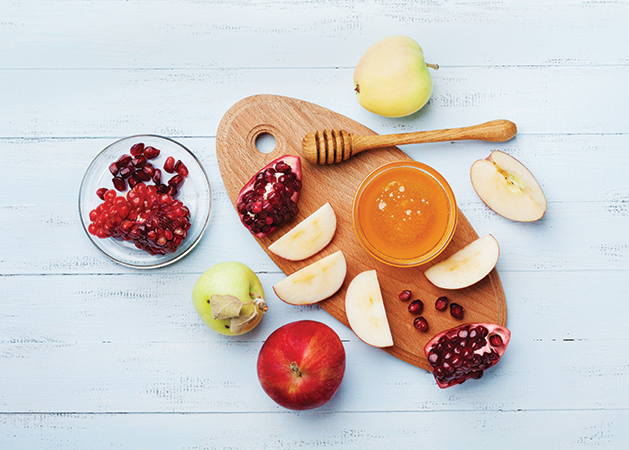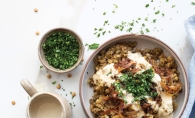
Plymouth resident Joyce Greene is from an Ashkenazi-Jewish family (Ashkenazim are Jews descended from Germany and Eastern Europe.) She grew up celebrating holidays with the traditional foods from her culture—with most of the fare involving beef or chicken. As an adult with a home of her own, Greene continued the tradition, preparing the same foods for her own family and friends. Everyone was happy—traditional holiday foods can create a comforting sense of continuity. And so it went for many years—Greene cooking and serving the foods that had been in her family for generations, treasured like the family heirlooms that they are.
Until there was a twist in the road—Greene became a vegetarian.
Greene remembers the first time she planned a Rosh Hashanah without meat. She wondered what her guests would think. “Would my Rosh Hashanah dinner guests be disappointed that our meal is sans brisket, sweet and sour meat balls or roasted chicken? As a late bloomer vegetarian, I needed to figure out a meatless meal that still would satisfy and hopefully establish some new traditions,” says Greene.
Greene began looking for vegetarian Jewish holiday foods, and found that Sephardic cuisine is rich in vegetarian dishes. (Sephardim are Jews who are descended from the Jewish communities of Spain and Portugal.) In the course of her search, she learned about a Sephardic custom—a Rosh Hashanah seder.
Many people in the broader community know about the custom of a Passover seder, but the ritual of the Rosh Hashanah seder is one that’s unfamiliar even to many Jewish people who were brought up in the Ashkenazi tradition.
Learning about Sephardic foods led Greene to a new family tradition. “I had never heard of it, but I now had a theme for our veggie holiday meal, a Sephardic seder, says Greene. (“Seder” means “order” in Hebrew—the festive meal is called a seder because the blessings over the various foods are recited in a certain order.)
Greene contacted the people she had invited to her Rosh Hashanah dinner, and explained that this year, there would be something new. “I let our guests know that we would be having a seder for Rosh Hashanah, and that I would explain more during the meal. I let them know that the following foods are symbolic for the Sephardic holiday meal: beets, yams, pumpkins, squash, pomegranate seeds, dates, apples and leeks. I suggested that they bring a dish that incorporates one or more of the above,” tells Greene.
“Our family did not disappoint,” says Greene. “They arrived with beautiful dishes, including a salad with pomegranate seeds, a roasted beet salad with endive, mint and feta, yams with apples and raisins and a fragrant pumpkin bread.”
For a main dish, Greene made Seven-Vegetable Couscous. As in many cultures, the number seven is considered to be lucky in Jewish tradition. “The vegetables are meant to represent wishes for good luck in the coming year,” says Greene.
“As the meal began, I explained that the seder would include special prayers for each of the symbolic foods, just as is done in a Passover seder. In this case, the prayers would be over a variety of foods that symbolize our wishes for bounty, strength and peace in the coming year,” says Greene.
“Happily, the Seder satisfied their taste buds as well as their curiosity about some new traditions,” says Greene. She continues to serve the Sephardic vegetarian dishes at Rosh Hashanah, and her cousin now incorporates some of the recipes, as well.
For some of Greene’s Rosh Hashanah recipes and suggested menus, check out the recipes below. The dishes are not only perfect for Rosh Hashanah—they make a great addition to any festive meal. They’ll be appreciated by everyone (well, almost), and especially by vegetarians.
Suggested menu for Sephardic or Vegetarian Rosh Hashanah:
Sephardic 7 vegetable Couscous
Roasted Beet Salad
Yams with Apples and Raisins
Salad with Pomegranate seeds
Pumpkin Bread
Vegetarian Matzah Ball Soup
Round holiday Challah Bread
Wine
Apple Cake
Sephardic Seven-Vegetable Couscous
Start to finish time: About 2 hours (less if you are speedy with food prep)
Servings: 6-8
3 cups water, and additional water as needed
1 1/2 cups couscous
1 tablespoon reduced-fat margarine
1 teaspoon turmeric
1 teaspoon salt
1 tablespoon canola oil
2 medium onions — chopped
2 large carrots — sliced
1 cup finely shredded white cabbage
1 medium turnip — peeled and diced
1 medium yellow summer squash — diced
1 1/2 cups canned or cooked chick peas
1 1/2 cups diced ripe tomatoes
1 teaspoon freshly grated ginger
1 teaspoon cinnamon
1/2 teaspoon ground cumin
1/2 teaspoon coriander
1/2 teaspoon turmeric
1/2 teaspoon salt
1/3 cup raisins
1/4 cup chopped fresh parsley
1/4 cup toasted sliced or silvered almonds
Directions:
Boil the water. In a heat-proof bowl, add the couscous, then add the boiling water. Cover
and let stand until the water is absorbed, about 15 minutes. Fluff with a
fork, then stir in the margarine, turmeric, and salt. Cover and set aside.
In a soup pot, add the oil and heat on medium-high flame until oil is heated. (Oil is ready when it flows smoothly and easily covers the bottom of the pan. If you’re unsure, drop a tiny piece of onion in. It is hot enough if the oil sizzles.) Add the onions and sauté over
moderate heat until translucent. Stir in the carrots and cabbage and sauté
until crisp-tender, adding small amounts of water as needed to keep the
bottom of the pot moist.
Add the turnip, squash, peas, chick-peas and tomatoes, ginger, the spices and salt, and raisins. Cover and cook over low heat for 15 to 20 minutes, lifting the lid to stir frequently. Add water in small amounts until the mixture has the consistency of a thick, moist (but not soupy) stew. The vegetables should be tender but still firm.
Before serving, arrange the couscous on the outer perimeter of a large serving platter. Pour the vegetable mixture into the center. Sprinkle with the parsley and almonds. Guests should place a small mound of couscous on their plates and top it with the vegetable mixture.
Roasted Beet Salad
Start to finish time: About 1 hour
Active time: 20 minutes
Servings: about 6
6 medium fresh beets, root and stems ends trimmed, rinsed
3 tablespoons water
1 whole red or yellow endive, finely sliced
1 medium red onion, finely sliced
½ cup red radishes, finely chopped
1 cup Kalamata olives, pitted
2 tablespoons. fresh chives, finely chopped
1 tablespoon fresh mint, finely chopped
1 tablespoon whole-grain mustard
1 tablespoon red wine vinegar
3 tablespoons fresh lemon juice
3 tablespoons. extra-virgin olive oil
1/2 teaspoon salt
1/2 teaspoon fresh ground black pepper
1 cup crumbled feta cheese
Directions:
Preheat oven to 400ºF.
In an over-proof casserole dish, add beets and pour in water. Cover with aluminum foil, and bake for 40 minutes.
Remove beets from the oven, remove aluminum foil, and place beets on a plate to cool completely.
After beets have cooled, remove the skin and cut beets into ½ inch cubes.
In a large bowl, add beets, red endive, red onion, radishes, olives, chives, and mint.
In a small bowl, whisk together whole-grain mustard, red wine vinegar, lemon juice, extra-virgin olive oil, salt, and black pepper.
Pour dressing over vegetables, and lightly toss. Top with crumbled feta cheese, and serve immediately.









